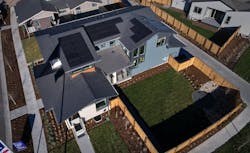A net-zero energy ready home isn’t just a standard home with the option to install solar panels on the roof. It begins with a different approach to product design that may involve rethinking site orientation, roof pitch, placement and types of windows, and exterior window shading, among other considerations.
Site Orientation and Home Energy Use
“Orientation impacts a building’s energy use. That’s a given,” says Mark LaLiberte, a partner at Construction Instruction, a building sciences training and consulting firm in Denver.
Simply, the home’s south-facing elevation is exposed to the path of the sun year-round, allowing the most daylight to the home’s interior to reduce the need for lighting and, in cooler times and climes, a measure of solar gain to offset the energy consumed for mechanical heating.
Conversely, west-facing elevations get the most intense solar exposure, especially in the summer. They should be designed to minimize heat gain, ideally with occasional-use rooms that do not need windows (think laundry, mechanical, and utility rooms, closets, and garages).
With that, designing and placing a home with a south-facing roof expanse (including that of the garage and covered balconies) is ideal for generating the most solar energy possible to supplement or replace utility-supplied electricity.
The optimum roof pitch at which to place a solar array for a net zero home generally coincides with the home’s geographic latitude, says architect Steven Baczek, of Steven Baczek Architecture, in Redding, Mass. “The more perpendicular it is, the more intense energy you’ll get from the sun,” he says.
RELATED ARTICLES IN THIS NET ZERO SERIES
Windows and Home Energy Demand
A double- or triple-glazed window with a lower solar heat gain coefficient (SHGC) allows less of the sun’s heat to transfer to the home’s interior.
“Let’s say a house is on a lot on a golf course. It has a beautiful view of the course, but it’s facing west,” LaLiberte says. “Triple-glazed windows with a very low solar gain and a bit of tinted glass will reduce the [size of the] air-conditioning system,” thus reducing the home’s energy demand or load.
Fewer windows can help, as well. “We try to balance good natural light inside the home against having too much glass,” says Jon Nieporte, spokesperson for Garbett Homes, in Salt Lake City. “Too much glazing can be a huge detriment to energy efficiency, as glass is not a good insulator and it carries a very low R-value compared with an insulated wall.”
A mixture of fixed and operable windows can also reduce air leakage and lower energy needs. “Fixed windows are less expensive,” Baczek says, “and they look pretty much the same as operable windows.”
Fixed windows can be a good choice as part of an expanded-view grouping of windows and in rooms with multiple windows that have a nice cross breeze between two operable units, among other scenarios.
Exterior shading devices, such as deeper roof overhangs and solar screens, as well as window blinds, can make windows more energy efficient by blocking solar heat when it’s not wanted, such as in the summer months.
“The shading device has to be outside because once the energy comes through the glass, it’s in the interior living space,” Baczek says. “Inside, all you’re doing is shading the light, not the energy.”
Testing the Limits for Net Zero
Sophisticated yet commonly available computer modeling helps builders test concepts and plans for net zero homes before they break ground. “Hire an engineer to model it and you’ll know what the impact of your choices will be,” says Daniel Thomas, CEO and co-founder of Hammer & Hand, a custom home builder in Portland, Ore.
The occupants’ lifestyle will affect how a home ultimately performs in terms of energy use, but modeling can help builders compare different site orientations, window types and placement, and other design options to help ensure performance.
Marcie Geffner is a freelance reporter specializing in real estate and banking. She lives in Ventura, Calif.

